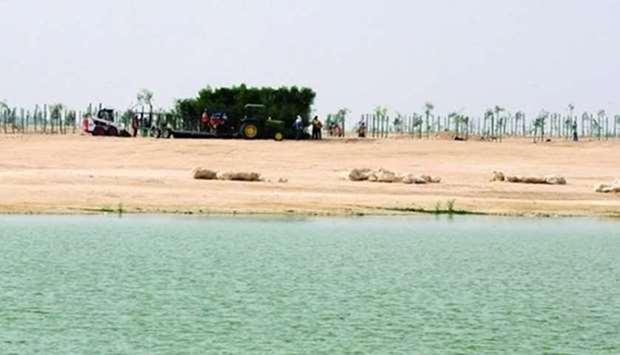Qatar's efforts to be self-reliant in agriculture got a shot in the arm with the reuse of treated wastewater, especially in the farm and for the irrigation of green-spaces, witnessing robust expansion both year-on-year and month-on-month this May, according to the official figures.
The rising reuse of treated wastewater comes amidst 10mn kgs of local vegetables being procured internally during the current crop season. The country uses the most modern membrane ultra-filtration system that helps in recycling of treated wastewater.
Qatar's treated wastewater stood at 25.17mn cubic meters out of 25.48mn cubic meters of wastewater received in May this year, said the figures released by the Planning and Statistics Authority.
The treated wastewater saw a 9.9% and 0.8% year-on-year and month-on-month growth respectively in May 2020.
There has been a robust reuse of treated wastewater in agriculture, a sector whose prominence has been increasing as part of the self-sufficiency initiatives, especially after the country came under unjust economic and trade embargo.
The treated wastewater reused in agriculture increased by 4.1% year-on-year to 8.39mn cubic meters, constituting more than one-third of the total treated wastewater this May (compared to 28% in April 2020). On a monthly basis, it witnessed an even higher 18.4% growth.
The growth in the re-usage of treated wastewater for agriculture hints at the hydrocarbons-rich country's Green initiatives, a key parameter of sustainability.
Hassad Food subsidiary Mahaseel for Marketing and Agri Services has undertaken various measures to improve and expand the output in the farm sector with its far-sighted marketing and other support measures.
The treated wastewater reused for irrigation of green spaces saw a 9.6% jump year-on-year and 21.3% month-on-month to 6.95mn cubic meters, which accounted for 28% of total treated wastewater in May 2020.
The treated wastewater reused in deep injection into aquifers registered 2.1% yearly expansion to 7.05mn cubic meters or 28% of the total treated wastewater in May 2020. On a monthly basis, it however fell 3.7%.
The treated wastewater discharged into lagoons in May 2020 stood at 2.78mn cubic meters or 11% of the total treated wastewater. Such discharge saw more than 91% increase year-on-year but fell 42.3% on monthly basis.
There was no discharge of treated wastewater into sea in May 2020.
The Water Centre at the Qatar Environment and Energy Research Institute, part of Hamad Bin Khalifa University, has been helping Qatar in tackling its water security challenges by conducting research, development and innovation to enhance every step of the water cycle in Qatar.
Multiple projects are currently underway at the Water Centre, including water treatment for agricultural irrigation in desert climates, development of physical filtration systems such as membranes and filters, brine management, ballast water, characterisation of the sub-surface and soils, and strategies for managed aquifer recharge.
Qatar's treated wastewater stood at 25.17mn cubic meters out of 25.48mn cubic meters of wastewater received in May this year, said the figures released by the Planning and Statistics Authority.
The treated wastewater saw a 9.9% and 0.8% year-on-year and month-on-month growth respectively in May 2020.
There has been a robust reuse of treated wastewater in agriculture, a sector whose prominence has been increasing as part of the self-sufficiency initiatives, especially after the country came under unjust economic and trade embargo.
The treated wastewater reused in agriculture increased by 4.1% year-on-year to 8.39mn cubic meters, constituting more than one-third of the total treated wastewater this May (compared to 28% in April 2020). On a monthly basis, it witnessed an even higher 18.4% growth.
The growth in the re-usage of treated wastewater for agriculture hints at the hydrocarbons-rich country's Green initiatives, a key parameter of sustainability.
Hassad Food subsidiary Mahaseel for Marketing and Agri Services has undertaken various measures to improve and expand the output in the farm sector with its far-sighted marketing and other support measures.
The treated wastewater reused for irrigation of green spaces saw a 9.6% jump year-on-year and 21.3% month-on-month to 6.95mn cubic meters, which accounted for 28% of total treated wastewater in May 2020.
The treated wastewater reused in deep injection into aquifers registered 2.1% yearly expansion to 7.05mn cubic meters or 28% of the total treated wastewater in May 2020. On a monthly basis, it however fell 3.7%.
The treated wastewater discharged into lagoons in May 2020 stood at 2.78mn cubic meters or 11% of the total treated wastewater. Such discharge saw more than 91% increase year-on-year but fell 42.3% on monthly basis.
There was no discharge of treated wastewater into sea in May 2020.
The Water Centre at the Qatar Environment and Energy Research Institute, part of Hamad Bin Khalifa University, has been helping Qatar in tackling its water security challenges by conducting research, development and innovation to enhance every step of the water cycle in Qatar.
Multiple projects are currently underway at the Water Centre, including water treatment for agricultural irrigation in desert climates, development of physical filtration systems such as membranes and filters, brine management, ballast water, characterisation of the sub-surface and soils, and strategies for managed aquifer recharge.




